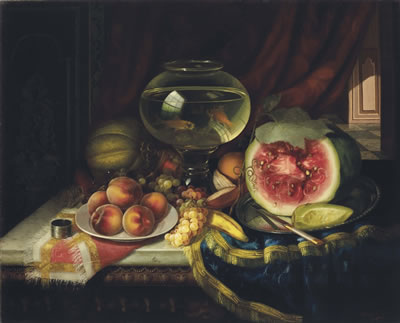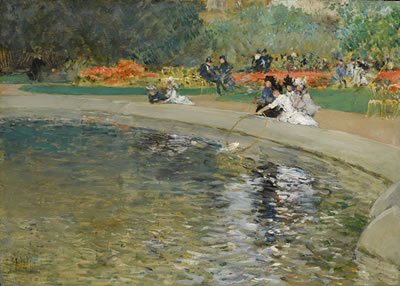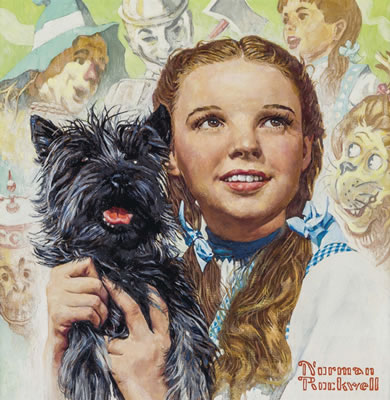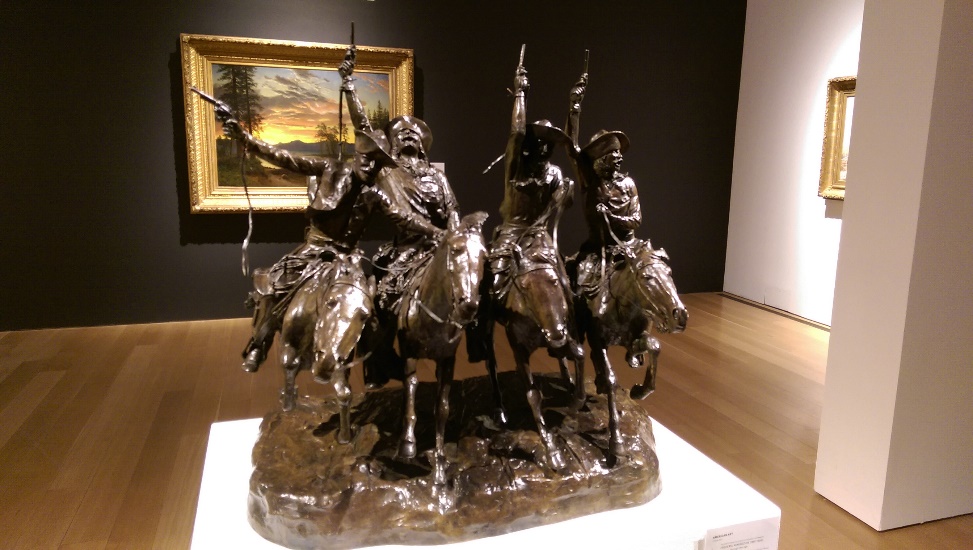Is there anything more embarrassing, fashion-wise, than looking at your high school yearbook 10 to 20 years after you have graduated? Those hair styles! That outfit! What on earth were we thinking? The embarrassment gradually subsides. And, who knows, beehive hairdos, mullets, or gimme caps may one day get sufficiently retro to be recycled.
These reflections were prompted by the performance of various schools of art at the American auctions last week. While 19th and early 20th century American art, as I have said in previous posts, is not nearly as sexy as contemporary art, the sales, though uneven, did show solid results in some areas. A synopsis would be as follows: modernism still strong, illustration art still strong, Western all right, Hudson River School spotty, Impressionism surprisingly iffy, and 19th century genre and still life paintings dead as a doornail.
These analyses are based on market performance this past week, not artistic quality. But what causes some schools to go out of favor and others to suddenly rise? In terms of fashion, why have lush Victorian-era still life paintings gone the way of capri pants? Consider the failure of this painting to sell.

This opulent still life is by Morston Ream (Morston Constantine Ream, to be exact. He and his brother Carducius Plantagenet Ream, also a still life painter, seem to have had parents who believed that children should have names to live up to.) I don’t know what Christie’s was thinking when they put a $100,000-150,000 estimate on the painting, when smaller still lifes by the artist regularly sell for four figures. The auctioneer at this sale ran the bidding up to $85,000 before giving up.
More surprising was the failure of this lovely little oil sketch by Childe Hassam to sell. I would put Hassam as one of the two or three finest American Impressionists (when he’s on his game – when he’s not, he can also be one of the worst). Twenty years ago, this painting would have been a slam dunk at $250,000-350,000.

But it didn’t sell, and other lovely works by important American Impressionists such as Willard Metcalf, Edward Redfield, and Everett Shinn failed to meet their reserves as well. What’s going on? Impressionism has always been a crowd pleaser; indeed, a curator once told me that the secret to being a successful museum curator is to get “the I word” into an exhibition title whenever possible, even if it means stretching the term a bit – “Impressionist Chinese Scrolls.” “Roman Bronzes – Forerunners to Impressionism.” “Peter Paul Rubens, Proto-Impressionist.” And I suspect that’s still true, as far as general museum admissions are concerned. The failure of the works mentioned above to sell has nothing to do with their quality. They are what they always were, but many wealthy collectors are now attracted to other styles. Auction reserves will have to be lowered to bring more buyers into the field.
What sold last week? Works by artists of the American West generally met or exceeded their estimates, as did works by African-American artists, showing that those markets continue steady. Works by painters once dismissed as “commercial artists” are now bringing prices on a par with the most august of “fine artists.” Norman Rockwell, of course, is the most prominent of these. A large oil at Sotheby’s of two plumbers clowning around, estimated at $5 to 7 million, sold for just under $15 million, including premium. And even a late small piece, done as an advertisement for a 1969 re-release of The Wizard of Oz, blew past its $200,000-300,000 estimate to sell for $727,500, including premium.

Nostalgia sells, though it has to be your nostalgia. No one is nostalgic for the scenes or settings that our great-grandparents sighed for.
Speaking of nostalgia, I’ll end on a personal note. Christie’s was offering Frederic Remington’s famous sculpture Coming Through the Rye last week. It brought $11,223,500, including premium.

As I watched it sell, my mind went back more than 23 years to the last time but one a cast of the bronze was sold at auction (A genuine cast, that is — recasts and outright fakes abound. Call me before you buy a Remington bronze.) The sculpture sold then for $1,212,500 to a gallery for which Lily Downing and I were working at the time. We were tasked with getting the piece across town to be the pièce de résistance at a reception the gallery was hosting that night. There was no time to book a fine art handler, so Lily and I drove to Sotheby’s in her much-used Honda Civic, put down the back seat, swaddled the sculpture in a few blankets, and drove to the gallery. I still shake my head over the contrast – a million-dollar hunk of metal inside a dented hunk of metal worth a couple of thousand bucks. The latter hunk of metal was melted down for scrap a long time ago, while the former has increased in value to more than eleven times its worth that day.
I can’t promise that the work of art you purchase from me today will increase by a like amount over the coming years. Fashions come and go. If you buy art as I advise, however, I can promise a lot of satisfaction. Let’s get started.

